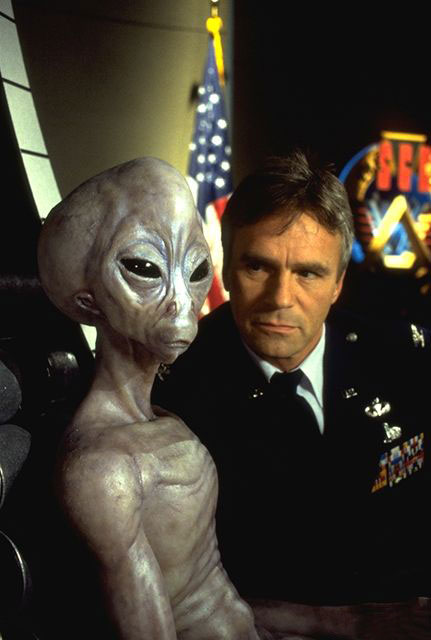To EBE or not to EBE, that is the question
(Illustrated with pictures of aliens to keep the text from seeming too dry…)

Even using incredibly conservative input values, the Drake Equation tells us there should be at least 100 other sentient species out there in our galaxy alone. But that result doesn’t express the incredible distances or the incredible amount of time that those 100 species have to fill up. IF all 100 species were around at the same time, and evenly spaced throughout the galaxy, each would find that the average distance to another race’s homeworld would be about 11,200 lightyears (a lightyear is the distance light travels in one year. One lightyear = about 6 trillion miles.)

Would they all exist at the same time? Let’s look at ourselves: It’s popular (I don’t know why) to talk about the end of Humanity, that at some point our race will just peter out. But what if we make it past religion, and past teabaggers, and past overpopulation, and manage to expand out to the planets and eventually the stars? Would there be any reason to assume we’d just stop reproducing at some point? I don’t think so. Of course, we would continue to evolve – and probably in different directions on different planets. How long would it be before a kid born on Mars no longer considered herself Human? How long before a kid born on Tau Ceti 3 considers himself a Tauian and not a Human? What if we forward the clock 100 million years (a blip, cosmically?) Would everyone on Earth be a floating brain? Would we all have retreated into mechanical bodies? Who knows? But the point is, our line would still exist. We would still be one of those 100 species occupying the Milky Way.

So how far would we go? How far would we expand? Well, there’s this meddlesome thing called the speed of light. As far as we know, nothing can move faster than the speed of light. Of course, sci-fi is full of warp drives, wormholes, stargates, hyperspace, etc. Why? Are any of those even remotely possible? Short answer: no. Then why does everyone use them in sci-fi? For the same reason Gene Roddenberry added the transporter to Star Trek: to streamline the story. If it takes, say, seven years to get to the nearest star, well, that’s the only story you can tell. If it takes 20,000 years for the Millennium Falcon to fly from Tattoine to Alderaan, the princess will be long dead by the time Luke and Han get there to save her. Faster-than-light travel is a staple of sci-fi for the same reason TV police departments all seem to have access to magical computers that can read a license plate from half a mile away just because you pressed the ENHANCE button on a grainy photo: it streamlines the story. Does it accurately reflect how things work in the real world? Not even close.

If we can’t go faster than light, and it takes X amount of time and X amount of energy to even get up NEAR the speed of light, how long will it take to get to another star? Well, Tau Ceti, which is the nearest kinda-Sun-like star, is about 12 lightyears away. If you built a spaceship dozens of miles long (to hold all the fuel you’d need) and had it accelerate at 1g for half the trip (firing its rocket all the way,) then decelerate at 1g for the last half (firing its rocket in the opposite direction,) it would take about 14 years to get to Tau Ceti. Keep in mind that there are a couple dozen show-stopping technical hurdles to such a trip that we are perhaps a generation or two away from solving. But assuming we can, and we do, we could make the trip to some really nearby stars relatively quickly.

What about going out and looking for the nearest species to our own? Well, using that ginormous ship that can accelerate at 1g, it would take 11,209 years to go 11,200 lightyears. But the people on the ship, because it would get so close to the speed of light, would only see the trip as taking 18 years. That’s fine for them. But the folks back on Earth would see the trip as taking LONGER THAN ALL OF RECORDED HISTORY. And once the ship got out that far it would take another LONGER THAN ALL OF RECORDED HISTORY for them to send a signal saying, “We made it.”

Okay, well, say we decide to do it anyway. We decide to go for broke and send a ship on an 11,209 year journey. Which way do we go? Remember, space is 3-dimensional. Imagine a gigantic sphere 11,200 lightyears across. There are hundreds of millions of stars out at that distance. Which one might have life? Probably the easiest way to find out would be to listen for radio signals (we’re actually doing this right now – none yet.) But the other species would have to be sending a signal on purpose, and in our specific direction. You commonly hear in sci-fi about how our radio and TV broadcasts travel out from our planet at the speed of light, and they’ve already reached a number of nearby stars. Well, yes and no. Take Roosevelt’s “A day that will live in infamy” speech from 1941. That was 69 years ago. So, shouldn’t it have traveled 69 lightyears? Sure, but even though the speech was sent out via the most powerful transmitters of the day, by the time the signal got to even the Moon, no radio could pick it up. The signal is scattered as it flies outwards, and before long, it’s vanished in the cosmic background noise. Knowing this actually comforts me, as it means any nearby aliens are unaware of Glen Beck.

But what if we send a signal from a radio telescope, on purpose, into deep space. Will that work? It should, and we’ve tried it a couple of times. But the signal scatters quickly. It can only work if the specific nearby star we’re aiming at has someone listening in the right direction at the right time.
All that being said, say we move forward a hundred thousand years and we’ve got vast colonies (really, they’re their own civilizations now) on planets around other stars. And we’ve set up an extensive network of space-based transmitters and receivers calling out and listening to millions of different stars (but again, remember, if we send a signal to a star 11,000 lightyears away, the absolute soonest we’ll hear back will be in 22,000 years, which right now is about how long Homo Sapiens have existed.) Finally, we hear a signal and decide to go visit. The ship leaves and may or may not be back in 22,018 years with trinkets and knowledge from our alien brethren. And while we might sign some sort of pact with them – whatever that means – we’re never going to have a Star Trek style Federation or a Star Wars style Galactic Empire.

These numbers are all really huge and it’s hard for us to even imagine how much Earth might change in 22,000 years (the time to get out there and back again.) But maybe life is a little more common. After all, we know of three places in our solar system alone where life did or could have started. So let’s square the number of species. 100 times 100 = 10,000. And now, on average, different species will be 1,200 lightyears apart. Hey! That’s nothing compared to before! Okay, but it’s still 2,400 years to send a signal and get a reply, which is from now to ancient Greece. And there are still over 100 MILLION stars in that volume of space, so it will take a while to say, “Hi” to all of them.

And what if there’s a species just 1,200 lightyears away from us, and they’ve been around for 10 million years, and they’ve been expanding out and colonizing on a regular basis? Well, again, there are over 100 million stars in “their” volume of space, so even if they sent out a new colony ship every single year since they first started walking upright (or whatever they do,) they would only have visited 1/10th of the stars in their own neighborhood. And sending out ships to travel to another star at high speed is a very resource-intensive proposal, even if they figure out how to harness something exotic like antimatter. So realistically, they probably haven’t visited even 1/100th of the stars in their neighborhood in the entirety of their existence.

So why am I babbling on about all this? Well, it’s my way of saying that I find it highly doubtful that small gray men are traveling across over 1,000 lightyears of space just to abduct random Humans and probe them anally. First, another species even finding us would be a lotto-winning-level piece of luck. Second, even though they evolved in a totally different, unimaginable way, they still have to deal with the same laws of physics as we do, and I’m guessing they wouldn’t construct a miles-long spaceship and spend a decade fueling it with antimatter just so they could come here and check up on the health of our colons.
Third, a ship decelerating at 1g into our solar system would be visible in the night sky for decades before it arrived. So there’s that.
Okay, so there we have it. Chance of other sentient life nearby in the galaxy: almost 100%. Chance they’re visiting us right now: 0.00000000000000000000001%.

But what about the luck of the draw? Maybe another species evolved close by. Maybe Tau Ceti – only 12 lightyears away – has life. Sure, that’s entirely possible.
And what about the fact that we don’t know everything, so there might be such a thing as warp drive, and we just haven’t figured it out yet? I mean, 100 years ago we could barely fly! That’s true. But unlike 100 years ago, we’ve learned enough about the universe to know that we’re right about at least the broad strokes: There was a Big Bang, the universe is expanding, and it will never stop expanding. Einstein’s theory coupled with Newton’s theory covers really big objects really well, and quantum mechanics covers really small objects really well. If we weren’t right about the broad strokes, the machine you’re reading this on wouldn’t exist. Of course, there are still tons of mysteries and finer points to figure out, but nobody is looking at a chalkboard or computer screen right now and saying, “Ah, that looks like a big hole in physics where we could fit the concept of a warp drive.” And chances are, they won’t. Ever.

But maybe 2,400 year journeys won’t be that big a deal in the future. What if we do all become floating brains, or cyborgs, or someone comes up with an immortality pill and the average lifespan becomes 50,000 years? Suddenly waiting for someone to come back from a 2,400 year trip only takes up 1/20th of your lifespan. That’s about how things worked early on in Europe’s exploration of the New World.
So maybe we’ll slowly expand outward, building huge colony ships every 100 years or so, exploring new planets, founding new Human settlements. And in time, the people in those settlements might not consider themselves Human, but they’ll still be a part of us, and together we’ll be our own Galactic Federation. And maybe we’ll hear a signal from nearby, and discover a new species, and learn from them as they learn from us.
Or maybe, tomorrow night, an amateur astronomer will notice an odd object way out beyond the orbit of Neptune, with what looks like a plume of plasma in front of it, gradually, gradually, slowing down…
• (Cast, in order of appearance:)
• Gorn from “Star Trek”
• Alien from “Close Encounters of the Third Kind”
• Cantina Band from “Star Wars”
• Prawn from “District 9”
• Cannamite from “Twilight Zone” episode “To Serve Man” (IT’S A COOKBOOK!!!)
• Martian Ambassador from “Mars Attacks!”
• “Alien Autopsy”
• TV’s “Alien Nation”
• Martian from “The War of the Worlds” (1953)
• “Alien Endorses McCain” from “Weekly World News” (2008)
• Kang and Kodos from “The Simpsons”
• Thor from “Stargate: SG-1”